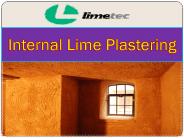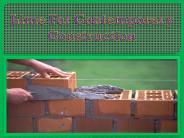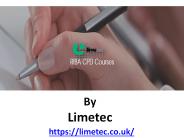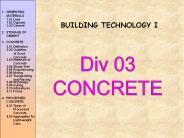Lime In Mortar PowerPoint PPT Presentations
All Time
Recommended
When people refer to lime mortar they're generally referring to mortar made with hydraulic lime or fat lime putty, sand and no cement. However, for most modern bricklayers and builders, the only exposure they've had to lime products is hydrated lime.
| PowerPoint PPT presentation | free to download
Lime mortar benefits in the modern world of Construction https://limetec.co.uk/hydraulic-lime-mortars/
| PowerPoint PPT presentation | free to download
Ready mixed colour hydraulic lime mortars are the perfect choice for listed buildings and conservation areas which require repairs or new builds.
| PowerPoint PPT presentation | free to download
Lime Mortar has been used in the construction of buildings for over 2000 years, and used on the most iconic historical landmarks across the world. For example, the Great Wall of China, the Houses of Parliament and Rome Colosseum. These historical buildings are still here today, due to its unique beneficial properties.
| PowerPoint PPT presentation | free to download
We pride ourselves on supplying the finest lime mortar at competitive prices, backed up by friendly technical advice and aftercare. We have our expert team with over a decade of experience specialising in the conservation of listed buildings, offering practical advice based on real-world experience.
| PowerPoint PPT presentation | free to download
Limetec lime putty is produced by slaking Quicklime in an excess of water. Our lime putty is mainly used for old buildings, and historic properties where maximum permeability and flexibility is required.
| PowerPoint PPT presentation | free to download
Lime mortar has been used in the construction of buildings for over 2000 years, and has been used on the world most iconic historical landmarks across the world; for example, the Great Wall of China, the Houses of Parliament and the Colosseum. These historical buildings are still here today, due to its beneficial properties.
| PowerPoint PPT presentation | free to download
Find out why London Lime Mortar is changing the way for listed buildings across London
| PowerPoint PPT presentation | free to download
Natural Hydraulic Lime mortar consists of two building materials, lime and sand. They can be used for a variety of applications for laying brickwork, bedding tiles, rendering and plastering
| PowerPoint PPT presentation | free to download
Our mortars are ready mixed at our state of the art factory. This removes the possibility of inconsistent colour and strength that can occur during site mixing.
| PowerPoint PPT presentation | free to download
We pride ourselves on supplying the finest lime mortar at competitive prices, backed up by friendly technical advice and after care. We have our own expert team with over a decade of experience specialising in conservation of listed buildings, offering practical advice based upon real world experience.
| PowerPoint PPT presentation | free to download
Pointing is the action of filling the gap between masonry units (joints) with a mortar to protect the masonry from water ingress and associated decay.Before any work begins it is important to observe how the wall was originally built and take note of this
| PowerPoint PPT presentation | free to download
Lime Mortar has been used in the construction of buildings for over 2000 years, and used on the most iconic historical landmarks across the world. For example, the Great Wall of China, the Houses of Parliament and Rome Colosseum. These historical buildings are still here today, due to its unique beneficial properties.
| PowerPoint PPT presentation | free to download
Our mortars are ready mixed at our state of the art factory. This removes the possibility of inconsistent colour and strength that can occur during site mixing.
| PowerPoint PPT presentation | free to download
A lime binder must be cured once it has been placed because it requires time to fully hydrate before it acquires strength and hardness. Curing is the process of keeping the mortar/render under a specific environmental condition until hydration is relatively complete
| PowerPoint PPT presentation | free to download
Lime has been used for thousands of years and we see many examples of historical buildings and structures which are still standing today. In recent history, with the expansion of the railwayindustry, we saw lime mortar used extensively in the construction of bridges, tunnels and viaducts.
| PowerPoint PPT presentation | free to download
Hair or Fibres have traditionally been used as reinforcement in lime renders as a means of improving tensile strength and to reduce shrinkage cracking. Introduced into the mix by teasing the hair into the mix prior to the mortars use. This is a time-consuming job as it involves teasing the hair into the mix as it is mixed. Clumps of hair simply cannot be placed into the mixer as they will remain in the mix as large balls of hair and will not part no matter what type or method of mixing is used.
| PowerPoint PPT presentation | free to download
The use of natural lime mortars and renders has increased considerably in recent years compared to just a couple of decades ago. These simple, basic materials are fundamentally important to the long term survival of historic buildings, yet there are many who still regard their use with suspicion.
| PowerPoint PPT presentation | free to download
Limetec NHL 3.5 Moderately Hydraulic Lime Mortar (HLM 3.5) can be used for permeable masonry materials which is mainly used above ground.
| PowerPoint PPT presentation | free to download
90 day old specimens made with 1:3 lime putty : aggregate. Calcitic stone aggregate ... specimens made with lime putty. Calcitic stone aggregate. Silicate sand ...
| PowerPoint PPT presentation | free to view
Limepoint is a lime pointing mortar designed specifically for pointing joints by a modern mortar gun or bag injection.
| PowerPoint PPT presentation | free to download
Limepoint is a lime pointing mortar designed specifically for pointing joints by a modern mortar gun or bag injection. Limepoint is perfect solution for stone cladding walls or for conventional wall, which require repointing.
| PowerPoint PPT presentation | free to download
The promotion of modern gypsum-based plasters has led to the almost complete demise of lime plastering, and of many of the traditional skills associated with the craft. This has been exacerbated by the plastering trade being divided into flat and decorative work
| PowerPoint PPT presentation | free to download
Mortar is made up of cement and sand. Concrete is made from this material. The best mortar manufacturers in Delhi produce a wide range of mortar types. If you are looking for the best mortar then visit our official website.
| PowerPoint PPT presentation | free to download
hydraulic lime has been used as a binder for brick, stones and masonry for thousands of years. Before 1900 nearly all buildings constructed across Europe will have been built using it, and many parts of Europe are still using it for new builds.
| PowerPoint PPT presentation | free to download
The benefits of using lime to create a vapour open construction are well known for historic solid walled buildings, however its use in modern construction is not so well documented.
| PowerPoint PPT presentation | free to download
Bonds units together & provides overall soundness ... hardwall plaster. Mortar below ground should not use lime, rish of reaction with soil. ...
| PowerPoint PPT presentation | free to view
Welcome to our blog, where we explore the world of lime and its various uses. Lime has been used for construction and building purposes for centuries. Additionally, even today, it continues to be a popular building material in the world of construction. One of the most significant distinctions within the lime category is hydraulic and non-hydraulic lime.
| PowerPoint PPT presentation | free to download
According to the latest research report by IMARC Group, The global lime market size reached US$ 46.2 Billion in 2023. Looking forward, IMARC Group expects the market to reach US$ 63.3 Billion by 2032, exhibiting a growth rate (CAGR) of 3.57% during 2024-2032. More Info:- https://www.imarcgroup.com/lime-market
| PowerPoint PPT presentation | free to download
Lath and plaster is a building technique used mainly for interior walls in period buildings. A lath is a narrow strip of wood approximately 2 inches wide which is nailed horizontally to each stud in the frame.
| PowerPoint PPT presentation | free to download
In the world of construction and property development, quality matters. From the foundation to the finishing touches, every element of a building project plays a crucial role in determining its long-term value and durability.
| PowerPoint PPT presentation | free to download
A damp building can cost a considerable amount of time and money to put right. Damp allows mold and fungi to prosper, which is directly linked to respiratory problems and affect asthma sufferers .
| PowerPoint PPT presentation | free to download
Sands specified for concrete tend to be used for mortars regardless of ... The term Kandoxi was introduced by Joseph Davidovits of geopolymer fame for mixed ...
| PowerPoint PPT presentation | free to download
Lime renders were traditionally applied to give protection to walls built of poor quality rubble stone or porous brick or to walls in exposed locations facing driving winds. They help by acting like a sponge, absorbing rainfall then allowing it to evaporate rather than soak into the wall
| PowerPoint PPT presentation | free to download
Like everything else, the structure of your brick walls eventually deteriorates. The brick mortar between the mortar joints eventually tends to wither away, and atmospheric agents play a major role in this. It’s even possible to find some bricks breaking off when water seeps into the joints. For this reason, you will need to use brick pointing to revitalize the structure of your bricks. This involves using cement mortar or lime mortar to repair or finish the brick mortar joints.
| PowerPoint PPT presentation | free to download
Like everything else, the structure of your brick walls eventually deteriorates. The brick mortar between the mortar joints eventually tends to wither away, and atmospheric agents play a major role in this. It’s even possible to find some bricks breaking off when water seeps into the joints. For this reason, you will need to use brick pointing to revitalize the structure of your bricks. This involves using cement mortar or lime mortar to repair or finish the brick mortar joints.
| PowerPoint PPT presentation | free to download
Like everything else, the structure of your brick walls eventually deteriorates. The brick mortar between the mortar joints eventually tends to wither away, and atmospheric agents play a major role in this. It’s even possible to find some bricks breaking off when water seeps into the joints. For this reason, you will need to use brick pointing to revitalize the structure of your bricks. This involves using cement mortar or lime mortar to repair or finish the brick mortar joints.
| PowerPoint PPT presentation | free to download
Like everything else, the structure of your brick walls eventually deteriorates. The brick mortar between the mortar joints eventually tends to wither away, and atmospheric agents play a major role in this. It’s even possible to find some bricks breaking off when water seeps into the joints. For this reason, you will need to use brick pointing to revitalize the structure of your bricks. This involves using cement mortar or lime mortar to repair or finish the brick mortar joints.
| PowerPoint PPT presentation | free to download
Our RIBA CPD presentation on the Benefits of lime mortar is interactive seminar with samples of our lime mortar materials and the benefits of use for building renovation, restoration and sustainability.
| PowerPoint PPT presentation | free to download
Carbonating Mortars Abatement, Sequestration and Waste Utilization in the Built Environment Earthship Brighton (UK) The first building utilising TecEco eco-cement ...
| PowerPoint PPT presentation | free to download
Making concrete Aim: ... Transparent, translucent, brittle, hard, semi-solid Mortar Mortar made with cement & sand is stronger & sets faster than lime mortar.
| PowerPoint PPT presentation | free to view
Ceramic Tiles. Flat glass. Lime, Gypsum, Mortar. Steel ... ASSOPIASTRELLE Ceramic Tiles. ASSOVETRO Flat glass. CAGEMA Lime, Gypsum, Mortar. FEDERACCIAI Steel ...
| PowerPoint PPT presentation | free to view
... Mortar (campuran ... kadar Ca silikat/aluminat Semen Portland Tipe I ... Clinker/Gypsum Silo Clinker Grinding Cement silos Lime stone clay ...
| PowerPoint PPT presentation | free to download
The requirements for totally hydraulic limes and all hydraulic concretes is to ... For carbonating eco-cements and lime mortars on the on the hand the matrix must ' ...
| PowerPoint PPT presentation | free to view
already need the CE-marking (1) Admixtures for concrete, mortar & grout system 2 Aggregates system 2 or 4. Building hardware system 1. Building lime system 2 ...
| PowerPoint PPT presentation | free to view
Portland cement is the most commonly used grade of cement around the world as a basic ingredient of concrete, mortar, stucco and grout. It was developed from different kinds of lime in England in the mid-nineteenth century.Types of Portland cement, PPC, Portland Slag Cement, OPC 33 Grade, 43 Grade & 53 Grade.
| PowerPoint PPT presentation | free to download
Civilizations have always been built on a foundation of water, cement, and sand. Humans, on the other hand, are continually finding new ways to construct things as we evolve. Grout is a thick liquid that is used to reinforce existing buildings. It fills in gaps between tiles and closes the joints. Grout, unlike mortar, has a low viscosity and no lime, making it thinner and easier to work with. Unlike epoxy grout, our polymer-modified grout provides color consistency. It can hide imperfections in handmade tiles and bridge the joint thickness in some patterned designs. It is regarded as high-performance and is intended for use in more demanding environments.
| PowerPoint PPT presentation | free to download
Cement is a grey coloured, inorganic powdery substance made by calcining lime and clay. It has excellent hydraulic binding properties and results in a rock-like substance when mixed with sand, gravel, water, etc. It is used in the production of concrete, stucco, mortar, grouts, etc. the global ghee market has grown at a CAGR of 3.8% during 2009-2016, reaching a volume of 5.4 Million Tons in 2016. To get more information on cement market, Click here @ http://www.imarcgroup.com/cement-manufacturing-plant Request sample report @ http://www.imarcgroup.com/request?type=report&id=525&flag=B Find more reports on chemical & material research @ http://www.imarcgroup.com/categories/chemicals-market-reports Contact Us IMARC Group 309 2nd St, Brooklyn, NY 11215, USA Website: www.imarcgroup.com Email: sales@imarcgroup.com USA: +1-631-791-1145 Follow us on twitter: @imarcglobal
| PowerPoint PPT presentation | free to download
... Water + high pH Ca++ + = Ca++ Ca++ Ca++ Clay (SiO2 ... story ! * Lime Applications Soil Treatment Soil improvement ... lime, it gives rise to heat.
| PowerPoint PPT presentation | free to download
CEMENTING MATERIALS 1.01 Lime 1.02 Gypsum BUILDING TECHNOLOGY I 1 ... CELITE To impart water-repellant or waterproofing qualities, e.g., hydrated lime, waterproofing ...
| PowerPoint PPT presentation | free to download
IJP, Countryside Building Properties of Lime-based Materials They are porous and absorb moisture from the surrounding bricks or stones.
| PowerPoint PPT presentation | free to download
When laid and maintained professionally, bricks and mortar can remain standing for many, many years – centuries in fact! However, despite their extreme durability, it’s not unusual for bricks to become dulled over time, and lose their original color that made them so visually appealing.
| PowerPoint PPT presentation | free to download
When laid and maintained professionally, bricks and mortar can remain standing for many, many years – centuries in fact! However, despite their extreme durability, it’s not unusual for bricks to become dulled over time, and lose their original color that made them so visually appealing.
| PowerPoint PPT presentation | free to download
Greeks: lime, sand, Santorin Earth, powdered pottery ... 'cement': in its late Latin and Old French designated materials now classed as ...
| PowerPoint PPT presentation | free to view
Exchange meeting EIG Euridice-SCK/CEN-ONDRAF/NIRAS - June 6, 2006. 1 ... The annular gap filling with cementitious grout or dry powder/pellets (lime or ...
| PowerPoint PPT presentation | free to view
























































